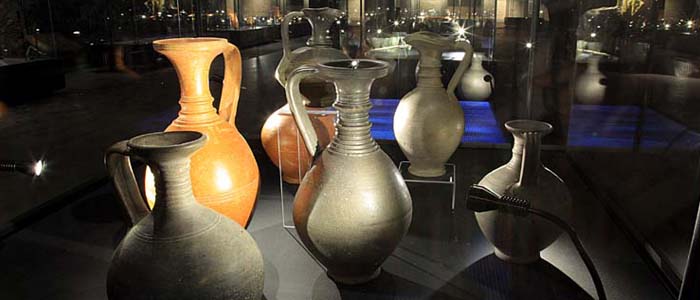
Late Antiquity marks the transition from Classical Antiquity to the Middle Ages. Characterized by important reforms that contributed to changes in economic and cultural development, it developed a strong economy and a new Late Roman culture. The entire archaeological collection of artifacts from the Late Antique period contains 563 items, which were acquired mainly from archaeological excavations and surveys, and by purchase. The items date from the 4th to the 6th century. The collection is characterized by an emphasis on variety and by a wide range of utilitarian and decorative items.
The artifacts in this collection are divided into the following groups: ceramic vessels, ceramic lamps, bronze lamps, silver and gold jewelry, glass, glass paste, bone objects, bronze fibulae, buckles, and marble decorative sculpture.
Among the ceramics, a group of Macedonian terra sigillata and North African vessels stands out; they date from the 4th and 5th centuries. Some of them were imported or made in local workshops under the influence of Italic or North African workshops. A rich collection of lamps from the 4th to 6th century may be found among the pottery.
A special place in the collection is dedicated to the exceptionally rich inventory of a Late Roman grave in the vicinity of Debar, which dates from the 4th century. In the grave were found two glass phiales, a gold fibula, a silver plate with rich decoration, a silver bowl, and other silver, bronze, and bone items. Among the grave goods, the glass cage cup or vas diatretum attracts special attention. The bronze lamps are decorated with Early Christian symbols, which were characteristic of that time; they date from the 5th and 6th centuries and originate from Stobi. An exceptional group of carved bone items with utilitarian or decorative purpose dates from the 6th century and originates from an Early Christian town near the village of Konjuh, Kratovsko. A particularly significant part of the exhibit is dedicated to a rich collection of ceramic icons from the fortress of Vinica; these valuable pieces of Early Christian art date from the 5th or 6th century. On them are shown relief depictions of saints and scenes from the Old and New Testaments. The decorative architectural sculpture includes marble capitals and parapet panels; the sculpture and mosaic segments, all dating from the 5th and 6th centuries, come from Konjuh, Suvodol, and Stobi.
In the permanent exhibition, in ten showcases, Late Antiquity is represented by 80 archaeological exhibits from the 4th to the 6th century. They include the glass cage cup (diatretum) and the complete inventory of grave goods found with it. Also on display are sigillata pottery and North African vessels and lamps. The finds from a Late Roman grave near the village of Zajas include two glass amphorae. Numerous items of jewelry and utilitarian artifacts of bronze, silver, glass, and bone may be seen as well as bronze lamps with Early Christian symbolism and some of the terracotta icons from Vinica. A reconstruction of the altar ensemble or presbyterium of the basilica at Suvodol, with its floor mosaic, completes the image of Late Antiquity.
These items represent the evidence for an important period during the Roman Empire, when deep political and economic changes led the transformation of the Roman Empire into the later form of Late Antique (Late Roman) culture or, in other words, toward the appearance of a new Early Byzantine culture, under whose influence significant changes began to take place on the territory of Macedonia.
Mila Shurbanoska, custodian advisor for Late antiquity
mila_surbanoska@yahoo.com




